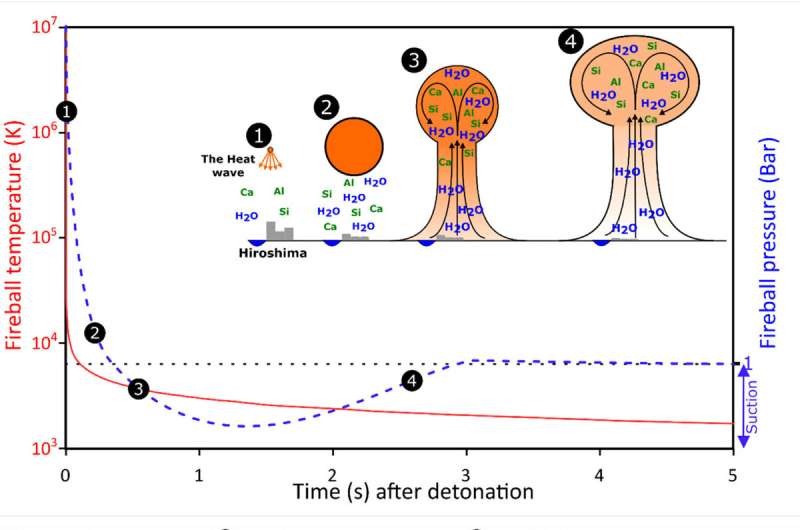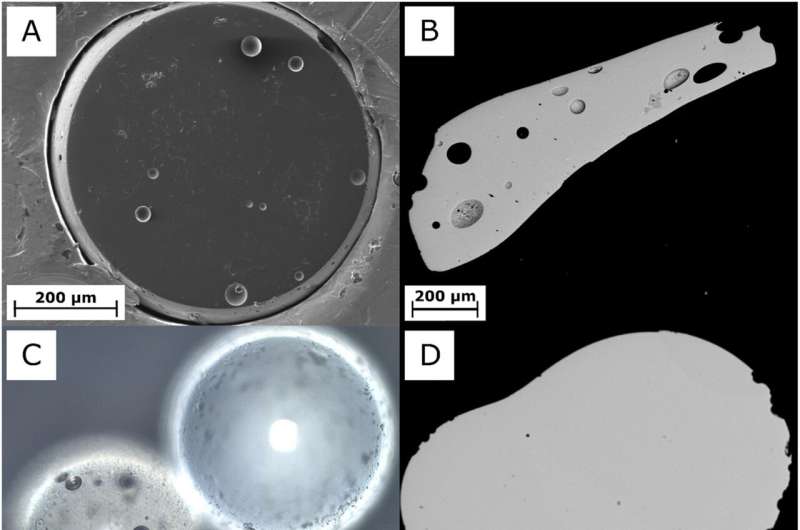February 22, 2024 feature
This article has been reviewed according to Science X's editorial process and policies. Editors have highlighted the following attributes while ensuring the content's credibility:
fact-checked
peer-reviewed publication
trusted source
proofread
Hiroshima fallout debris linked to first solar system condensates

The atomic bombing of Hiroshima, Japan, by the United States in August 1945 was not only devastating at the time, resulting in the deaths of hundreds of thousands of people, but it has had long-standing impacts to the present day, particularly the elevated incidence of cancer from radiation.
Continued research of Hiroshima Bay has uncovered a new kind of debris from the fallout, known as Hiroshima glasses. These formed from vaporized materials of the bomb and the surrounding landscape and infrastructure being targeted.
New research published in Earth and Planetary Science Letters has analyzed the chemical and isotopic compositions of these glasses to ascertain their formation process during the nuclear event.
Nathan Asset, of Université Paris Cité, France, and colleagues determined that rapid condensation (1.5–5.5 seconds) within the nuclear fireball (temperature 3,200–1,000 Kelvin) was the primary process. This is akin to the process by which the first solids (condensates) in the solar system, calcium-aluminum-rich inclusions (CAIs) of primitive meteorites (chondrites), would have formed from the vaporization of interstellar dust and nebula gas.
To investigate this further, the research team identified four types of glasses within the 94 specimens of fallout debris: melilitic (low silica, high calcium oxide and rich in magnesium oxide), anorthositic (high aluminum oxide contents and iron-bearing), soda–lime (rich in silica and sodium oxide) and silica (~99% silica). The origin of the silica glass could not be separated from sand grains on the beach, but the soda–lime glasses are similar to compositions of industrial origin.

Reconstructing the formation of these glasses, the researchers state the plasma fireball exploded 580 m above the city with a radius of 260 m, a peak temperature of 107 K and a pressure of 106 atmospheres. A thermal wave touched the ground at temperatures of 6,287°C.
Within a mere 0.35 seconds, the pressure dropped to match that of the surrounding atmosphere and within 10 seconds the temperature decreased to 1,500–2,000 K and vaporization ceased. In the immediate 0.5–2 seconds after the explosion, city materials (concrete, iron and aluminum alloys, industrial glass and soil) were vaporized and mixed with sand, Ota River water and the atmosphere to produce the various glasses.
There is some difficulty in estimating the actual quantities of each component that was vaporized, as not all buildings were destroyed; for example, some built to withstand earthquakes did survive the blast and therefore some concrete, iron and bricks were not vaporized.
Additionally, different materials require different amounts of energy to vaporize and therefore form condensation nuclei at different stages of the glass-forming process (e.g., river water inclusion would be sustained for longer as it requires less energy than concrete).
The isotopic composition of silica within the Hiroshima glasses was -23.0 ± 1.8 ‰ to -1.5 ± 1.1 ‰, while that of oxygen via mass-independent fractionation was -3.1 ± 0.6 ‰, all of which fall within the realms of the composition of CAIs. The research team used the results of the fractionation to determine melilitic glasses were the first to form, then anorthositic, followed by soda–lime and finally almost pure silica.
While the composition of the environment of Hiroshima glass formation differs from that of CAIs (temperature 3,500 K for Hiroshima and 2,000 K for the solar accretion disk, 1 bar pressure for Hiroshima and 10-3–10-6 bar for solar disk, oxygen-rich environment for Hiroshima and hydrogen-rich for solar disk) and the time over which the events occurred (
More information: Nathan Asset et al, Condensation of fallout glasses in the Hiroshima nuclear fireball resulting in oxygen mass-independent fractionation, Earth and Planetary Science Letters (2023). DOI: 10.1016/j.epsl.2023.118473
Journal information: Earth and Planetary Science Letters
© 2024 Science X Network





















